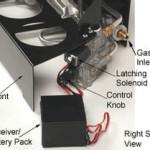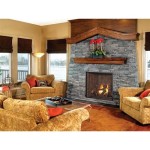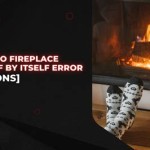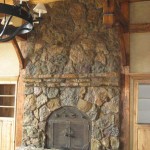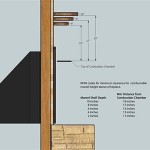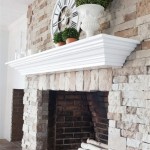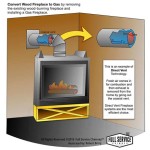Converting a Gas Fireplace into a Wood-Burning Fireplace: A Comprehensive Guide
The allure of a wood-burning fireplace, with its crackling logs and rustic charm, is undeniable. Many homeowners with existing gas fireplaces find themselves drawn to the idea of converting their units to burn wood instead. While seemingly straightforward, this conversion process involves significant considerations, modifications, and potential challenges. This article provides a detailed overview of the factors involved in converting a gas fireplace into a wood-burning one, including safety concerns, structural requirements, and the necessary steps to ensure a successful and code-compliant transformation.
Before embarking on this project, it is crucial to understand that not all gas fireplaces are suitable for conversion. The fundamental difference between gas and wood-burning fireplaces lies in their venting requirements and firebox construction. Gas fireplaces typically vent through smaller, B-vent pipes that are designed to handle the relatively low temperatures and byproducts of gas combustion. Wood-burning fireplaces, on the other hand, require larger, more robust chimney systems capable of withstanding extremely high temperatures and safely expelling smoke, creosote, and other combustion products.
Attempting to burn wood in a gas fireplace without the proper modifications can create a dangerous situation, potentially leading to chimney fires, carbon monoxide poisoning, and structural damage to the home. Therefore, a thorough assessment of the existing fireplace and chimney system is the first and most critical step in the conversion process. This assessment should be performed by a qualified professional, such as a certified chimney sweep or a licensed fireplace installer.
Assessing the Existing Fireplace and Chimney System
The initial assessment will determine the feasibility of the conversion and identify any necessary repairs or upgrades. This evaluation typically involves inspecting the firebox, chimney liner, and surrounding structure for signs of damage, deterioration, or code violations. The key factors to consider include:
Firebox Construction: Gas fireplaces are often constructed with thinner metal fireboxes than wood-burning fireplaces. Burning wood in a firebox not designed for high temperatures can lead to warping, cracking, and eventual failure of the firebox. If the existing firebox is deemed insufficient, it will need to be replaced with a heavy-duty, fire-rated firebox designed for wood-burning.
Chimney Liner: The chimney liner is the internal lining of the chimney that protects the surrounding masonry from heat and corrosive combustion byproducts. Most gas fireplaces utilize B-vent pipes made of aluminum or galvanized steel. These pipes are not suitable for wood-burning fireplaces due to the higher temperatures and corrosive nature of wood smoke. A wood-burning fireplace requires a Class A chimney liner, constructed of stainless steel or ceramic, that is specifically designed to withstand the extreme conditions associated with wood combustion.
Chimney Size and Height: The size and height of the chimney are critical factors in ensuring proper draft and ventilation. An undersized chimney can restrict airflow, leading to smoke backdrafting into the home. The chimney must also extend at least three feet above the roofline and two feet higher than any structure within ten feet, per building codes.
Damper: A damper is a metal plate located within the chimney that controls airflow. Gas fireplaces often have dampers that are not designed to fully seal, as they rely on a constant flow of air for combustion. Wood-burning fireplaces require a tight-fitting damper to prevent heat loss when the fireplace is not in use and to prevent drafts within the home.
Clearances to Combustibles: Adequate clearances between the fireplace, chimney, and surrounding combustible materials (such as wood framing and drywall) are essential to prevent fires. Building codes specify minimum clearance requirements that must be adhered to during the conversion process.
Modifying the Fireplace for Wood Burning
Once the assessment is complete and the necessary modifications have been identified, the physical conversion process can begin. This typically involves the following steps:
Removing Gas Components: The first step is to disconnect and remove all gas components, including the gas line, burner, and any electronic controls. This task should be performed by a qualified gas technician to ensure that the gas line is properly capped and sealed to prevent leaks.
Replacing the Chimney Liner: As mentioned earlier, replacing the chimney liner is often the most crucial step in the conversion process. A Class A chimney liner must be installed to safely vent the high temperatures and corrosive byproducts of wood combustion. The liner should be properly sized to match the firebox opening and extend the full height of the chimney. The new liner will most likely need to be insulated. This can be done by pouring a thermal insulator like vermiculite between the new liner and the existing chimney structure.
Upgrading the Firebox: If the existing firebox is not designed for wood burning, it will need to be replaced with a heavy-duty, fire-rated firebox. The new firebox should be properly sized to accommodate wood logs and should be installed according to the manufacturer's instructions.
Installing a Damper: A tight-fitting damper should be installed at the base of the chimney to prevent heat loss and drafts. The damper should be easily accessible and operable.
Ensuring Proper Clearances: It is crucial to verify that all clearances to combustible materials meet building code requirements. Additional insulation or shielding may be required to reduce the risk of fire.
Installing a Hearth Extension: A hearth extension is a non-combustible surface that extends in front of the fireplace opening. It is designed to protect the flooring from sparks and embers that may escape from the firebox. The size of the hearth extension is determined by the size of the fireplace opening and building code requirements.
Navigating Building Codes and Permits
Converting a gas fireplace to a wood-burning fireplace typically requires obtaining building permits from the local building department. Building codes are in place to ensure safety and prevent hazards. Failure to obtain the necessary permits or comply with building codes can result in fines, legal action, and potential safety risks.
The permit application process typically involves submitting detailed plans and specifications for the proposed conversion, including information about the firebox, chimney liner, and clearances to combustibles. The building department may also require inspections at various stages of the project to ensure compliance with code requirements.
It is important to research and understand the specific building codes in your area before starting the conversion process. Consulting with a licensed contractor or fireplace installer can help ensure that the project complies with all applicable regulations.
In addition to building codes, there may be other regulations or restrictions that apply to wood-burning fireplaces, such as limitations on the type of wood that can be burned or restrictions on burning during certain times of the year. It is important to be aware of these regulations and comply with them to avoid fines or other penalties.
Modifying a gas fireplace into an operable wood burning fireplace also comes with some upkeep requirements. Wood burning inevitably leads to the buildup of creosote in the chimney. Annual chimney cleaning is required to minimize the risk of a chimney fire. This service is provided by certified chimney sweeps that have the tools to properly remove all residue left over in the chimney.
In conclusion, converting a gas fireplace to a wood-burning fireplace is a complex project that requires careful planning, assessment, and execution. While the allure of a wood-burning fireplace is strong, it is essential to prioritize safety and ensure that the conversion is performed according to building codes and manufacturer's instructions. Engaging qualified professionals, such as certified chimney sweeps and licensed fireplace installers, can help ensure a successful and safe conversion.

Gas To Wood Fireplace Conversion Overland Park Ks Firplace Service

Want To Convert Gas Wood Fireplace Full Service Chimney

Want To Convert Gas Wood Fireplace Full Service Chimney

Wood Fireplaces Gas Conversion That Counts

Convert Your Wood Or Gas Fireplace Fuel Type Conversions

Convert From Wood To Gas With A Insert The Kernel Burner

Convert Gas Fireplace To Wood

Can A Wood Burning Fireplace Be Converted To Gas The Flame Company

Want To Convert Gas Wood Fireplace Full Service Chimney

Converting A Fireplace To Wood Burning Stove Chesneys

